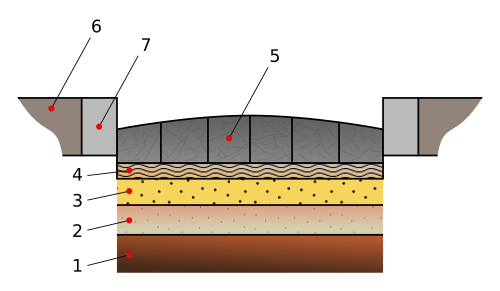Roman Britain/Roads and Streets
The Romans were famous for their roads, and this page describes how Roman roads were built and used.[1] The Romans built roads so that the army could march from one place to another. They tried to build the roads as straight as possible so that the army could take the shortest route.
- Watch the movie.
- Do the interactive exercise.
The general appearance of such a road and footway is shown in an existing street of Pompeii.[2]
Sort the different layers into the correct position:
7. edge-stones
6. Crepido: raised footway, or sidewalk, on each side of the via
5. Dorsum or agger viae: Paving stones formed the surface of the road. These were cut so they fit together tightly
4. Nucleus: cement mixed with broken potshards and lime.
3. Audits: Broken stones, pebbles, cement and sand to make a firm base
2. Statumen: a layer of big stones
1. Native earth, leveled and, if necessary, rammed tight.
The upper surface was designed to cast off rain or water like the shell of a tortoise. The lower surfaces of the separate stones, here shown as flat, were sometimes cut to a point or edge in order to grasp the nucleus, or next layer, more firmly.
Roman Britain
Weblinks
- ↑ Roman Roads in Britain (simple.wikipedia.org)
- ↑ Roman Roads Teaching Ideas (www.teachingideas.co.uk)
- Local Learning: Hadrian's Wall (english-heritage.org.uk)





